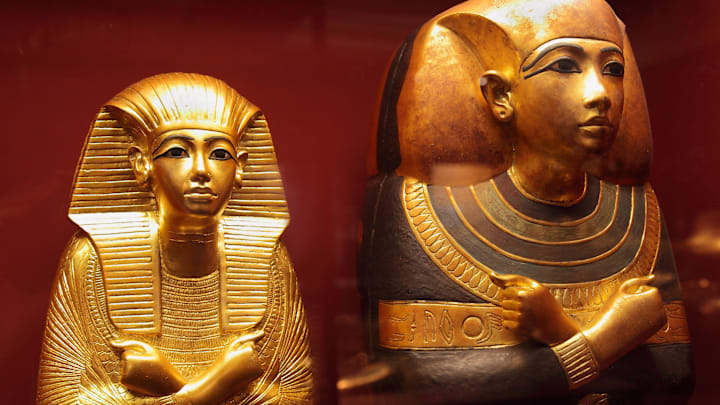When British archaeologist Howard Carter entered the tomb of King Tutankhamen in 1922, it had been mostly untouched for 3200 years. Flooding and debris from the construction of subsequent tombs in the Valley of the Kings worked to conceal the catacomb, saving it from centuries’ worth of plunderers. Inside was the mother lode of Egyptian artifacts: more than 5000 items, including artworks, handicrafts, jewelry, shrines, furniture, and ceremonial weapons—all part of the elaborate funeral rites that plunged Egyptian rulers into the land of the dead in ostentatious style.
A convention center in Washington, D.C., is recreating the chambers as Carter found them. In May, the Rhode Island Center became the latest venue to host “Tutankhamun: His Tomb and His Treasures,” an “immersive” traveling exhibit with over 1000 replicas of artifacts found in Carter’s expedition.

Semmel Concerts, the German event promoter behind the project, says they hired Egyptian artisans to painstakingly recreate the objects in consultation with Egyptologists [PDF]. An advisor to the project told Smithsonian that they had access to the originals and 3D scans of them and a team of craftspeople, lapidaries, and sculptors used a combination of plaster molds, resin, alloys, and glass appliques to recreate the artifacts down to the fine details.

Replicating the objects in King Tut’s tomb for public display is a practice almost as old as the tomb’s discovery. Carter’s excavation created a Beatlemania-like craze in the West for all things related to ancient Egypt. While Carter and the Egyptian government haggled over the items, an artist and an Egyptologist used photographs to create replicas for a 1924 London exhibit of items from across the British Empire—though Egypt was newly independent, which helped the country assert its claim on the items as pieces of cultural heritage.

In the late 1970s, as a byproduct of U.S. diplomacy, Egypt allowed some contents of the tomb to tour museums in six cities for a blockbuster exhibit. A vast majority of those artifacts are now in the Grand Egyptian Museum in Cairo and Egyptian antiquity laws have prevented another exhibit abroad.
Meanwhile, like a good cover band, the exhibit in Washington is presenting all the greatest hits from King Tut’s tomb: the scowling statute of Anubis with gold trim, the golden chariot, the wall paintings filled with iconography, the instantly recognizable striped golden burial mask, the models of ships and the gilded statues of servants meant to usher the boy king into the afterlife, and the multilayered sarcophagus that held the king’s mummy. Many are arranged, approximately, the way Carter found them to create a wraparound art experience like the recent exhibits that have put Van Gogh and Monet into 3D.
